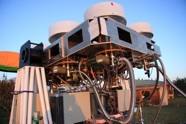Tzihong Chiueh

The coherent detector technology has been around for several decades in Radio Astronomy. It measures the electric field of incoming EM waves from the sky and takes advantage of the phase coherence of these waves for construction of the sky image with the Aperture Synthesis technique. One famous example of coherent detector instruments is the Very Large Array (VLA) of New Mexico, US, which appears in the movie “Contact”, in which Jodie Foster casted as a VLA astronomer.
The coherent detector technology is currently under rapid advancement, thanks to the technology drive of commercial 3G and 4G cellular phones. On one hand, cellular phones adopt a similar principle as a radio telescope to receive signals. On the other hand, cellular phones are highly integrated devices, with the so called system-on-chip (SOC) technology so as to make complex circuitry very compact.
Our on-going hardware project for the Extended-NTU-Array is to install highly compact electronic devices into every receiver so that there can be as many as 19 identical small receivers (or pixels) within one big receiver. This widens the telescope field of view by a factor of 19 in comparison with the conventional single-pixel receiver adopted for the present NTU-Array. We are collaborating with electrical engineering teams from Chiao-Tung U., Taiwan U., and Taipei Institute of Science &Technology for this multi-pixel receiver project. NTU/Astrophysics is responsible for receiver and optics designs as well as the backend electronics, and the EE teams are in charge of developments of specific chips and packaging. As examples of these efforts, the schematics of the 19 feeds in the big receiver is shown in Fig.(1), and a RF mixer SOC is given in Fig.(2).
NTU-Array Project:



